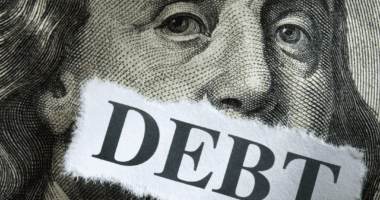Black Students Hold Too Much Debt, and the Way Out Includes More and Better Career Counseling
Student loan debt is a major concern.
Recent estimates suggest that the national student loan debt level is nearly $1.5 trillion, with the average college undergraduate graduating with about $30,000 in loans. While these estimates are staggering, debt challenges for Black students are even more alarming. The average debt of Black graduates is about $34,000 — higher than any other racial group.
Given the high debt levels that burden many Black students, a holistic approach is needed to address the student debt crisis for this group. The many interconnected parts of this approach should focus on critical areas that exacerbate higher-education affordability, including higher-education financial initiatives, pathways to college, early career guidance and broader racialized social issues.
Higher-education finance initiatives should be central to this holistic approach. Because a substantial percentage of Black students come from low-income families and rely on grants to pay for college, these initiatives should increase need-based aid, such as Pell Grants, and increase the purchasing power of these awards.
Further, these holistic initiatives should prioritize public support for high-quality colleges and universities that educate a substantial percentage of Black students, such as historically Black colleges and universities (HBCUs), predominantly Black institutions (PBIs) and community colleges.
Ultimately, more institutional support could help to keep tuition levels lower and reduce the overall cost of attendance. It could also help institutions to reallocate expenses and offer financial support to defray other college costs, such as books, supplies, room and board, transportation, and childcare. In addition to supporting institutions that educate Black students, support for equity-focused, large-scale college affordability plans could also reduce many Black students’ debt burdens.
Such programs differ from a number of existing free college proposals and initiatives in this way: They make targeted efforts to address the financial needs of marginalized students. Other useful higher-education financial initiatives include early financial awareness and literacy training to help Black students make savvy financial decisions. Similar initiatives are underway and could be expanded and institutionalized to help Black students navigate major financial decisions.
While higher education financial initiatives are an obvious way to address the Black student debt crisis, there are other areas where targeted interventions are needed. Structural barriers often prevent Black high school students from equitably accessing college-prep courses and materials, and that can have cost implications for those who overcome those barriers and go onto college.
As a result of de jure housing segregation during the 20th century and de facto housing segregation today, coupled with the inequitable and often unconstitutional way public K-12 education is funded, too many Black students are concentrated in under-resourced K-12 schools and require developmental courses in college.
Some national estimates suggest that 78% of Black students within two-year institutions and 66% of Black students within four-year institutions take remedial coursework. The need for developmental college courses can increase the overall cost of attaining an undergraduate degree and discourage persistence. In addition to preparing more Black students for college, dual-enrollment initiatives could reduce college costs by allowing these students to earn college credits while still in high school.
Like other higher-education sectors, dual-enrollment programs also under-enroll Black students. Recent statistics suggest that only 27% of Black students take courses for postsecondary credit while in high school, lagging behind all other racial or ethnic groups.
This is, undoubtedly, intimately connected to racial opportunity gaps in education that disadvantage Black communities in systemic ways. Ultimately, Black students’ access to adequate college preparation can have long-standing financial benefits. Structural barriers to such access can increase the overall cost of college and the likelihood that Black students will have to borrow more.
On another note, early career guidance could have debt implications for Black students. While it is not uncommon for students to enter college without set career goals or to change their majors, “figuring it out” while in college can be costly — particularly when it extends students’ time to degree.
This is especially important for Black students from families that have little or no disposable income for college costs. Early career exposure and guidance can help these students navigate postsecondary training in ways that are intentional and cost-efficient. To provide Black students with these opportunities, K-12 education must be funded equitably to ensure Black students attend schools with enough guidance counselors and college and career advisors.
Although holistic practices are important, the economic realities of Black families and the social structures that perpetuate these realities must also be addressed. Within the United States, there are long-standing racial wealth gaps and financial inequalities that should be an essential part of any conversation about Black students and college debt.
The point is simple: Families with less income and wealth have less money to pay for college. Eradicating pervasive racial wage and wealth gaps must be a part of a rounded assessment of Black student debt as well as any comprehensive solution. Gender wage gaps have been a recurring topic of discussion, and there is a history of legislation to eliminate this inequity in some states.
Similar initiatives to eradicate racial wage gaps are needed at state and federal levels. One approach involves increased transparency. While larger employers are now required to report employment data disaggregated by race and gender to the Equal Employment Opportunity Commission, making such data available to the broader public would bring more awareness to racial wage gaps and specific employers that perpetuate this phenomenon.
Also, while reputable institutions that serve a substantial percentage of Black students should receive increased public support, support for for-profit institutions that engage in predatory practices, which saddle students with high debt levels and credentials that have little to no value in the labor market, should be eliminated.
This should include a federal recommitment to protect students by imposing stricter regulations. College costs are generally higher in the for-profit industry, and Black students comprise over a quarter of enrollment at these institutions. This, undoubtedly, has an impact on debt issues for a number of Black students and requires immediate attention to resolve the Black student debt crisis.
Krystal L. Williams is an assistant professor of higher education in the Educational Leadership, Policy and Technology Studies Department of The University of Alabama’s College of Education.











